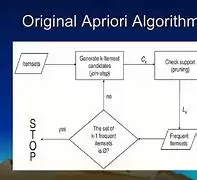Apriori algorithm with Python Code
Apriori algorithm Concepts
classic association rule learning algorithm used in data mining and machine learning to identify relationships between different items in a dataset. It is used to extract frequent item sets and association rules from large datasets, by exploring the relationships between different items based on their frequency of occurrence.
Here is an example of how the Apriori algorithm works: Suppose we have a dataset of customer transactions, where each transaction includes a list of items that the customer has purchased. We want to identify relationships between different items and use this information for targeted marketing campaigns. We use the Apriori algorithm to extract frequent item sets and association rules from the dataset. The algorithm works by first identifying all the frequent single items, then using these to generate frequent pairs, and so on until a stopping criterion is met.
Apriori algorithm Algorithm
- Define the problem and collect data.
- Set a minimum support threshold and a minimum confidence threshold.
- Identify all frequent itemsets that meet the minimum support threshold.
- Generate association rules for each frequent itemset that meets the minimum confidence threshold.
- Evaluate the model on a test dataset to estimate its performance.
python code
from extend.frequent_patterns import apriori
from extend.frequent_patterns import association_rules
import pandas as pd
# Load dataset
df = pd.read_csv('transaction_data.csv', header=None)
# Apply the Apriori algorithm to extract frequent item sets
frequent_itemsets = apriori(df, min_support=0.5, use_colnames=True)
# Apply association rule mining to extract association rules
association_rules = association_rules(frequent_itemsets, metric='lift', min_threshold=1)
# Print the association rules
print(association_rules)
Benefits of the Apriori algorithm for association rule learning:
- Can identify relationships between different items in a dataset.
- Can be used for targeted marketing and recommendation systems.
- can find trends and patterns in the data.
- Can handle large datasets with high dimensionality.
Advantages of the Apriori algorithm for association rule learning:
- Can handle noisy data and missing values.
- Can handle datasets with any shape or size.
- Can provide insights into the data structure and patterns.
- Can be used for data compression and speed up computation.
Disadvantages of the Apriori algorithm for association rule learning:
- For large datasets, the approach may be computationally expensive.
- The algorithm may not work well for high-dimensional data.
- The interpretation of the association rules may be subjective.
- The algorithm may not be suitable for datasets with continuous variables.
Main Contents (TOPICS of Machine Learning Algorithms)
CONTINUE TO (Collaborative Filtering Algorithms)


Comments
Post a Comment